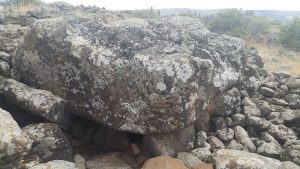The ancient monuments called dolmens are fascinating for a couple of reasons. First, although Iye-Abarim was located just northeast of the Dead Sea, the highest concentration of dolmens in the region is on and around the Golan Heights, where the Rapha king Og and the deity called Rapi’u, King of Eternity, once ruled. A recent survey of the Golan found more than five thousand megalithic burial sites, most of which are dolmens.[1] In Jordan, another twenty thousand dolmens have been found,[2] although many are threatened by the expansion of modern cities and quarrying for rock and gravel. (Which makes sense—dolmens were built where great big rocks were close to the surface and easy to find.) Secondly, and this is an interesting admission: Scholars really don’t know anything about the people who built them.
The dolmens are generally dated to the third millennium (3000–2000) BC. On the Golan Heights, they are more narrowly dated to between 2250 BC and about 1800 BC.[3] Based on pottery shards found near some of the dolmens in Jordan, the megaliths closer to the Dead Sea may be as old as the beginning of the Early Bronze Age, circa 3300 BC.[4]
If the Bible is accurate, and it is, then the time and location suggest that the builders of the dolmens were the Rephaim tribes, who constructed them in the centuries before Abraham’s arrival in the area. By the time the Israelites returned from Egypt around 1406 BC, only Og’s small kingdom remained of the Rephaim—possibly the last of the dolmen-builders in the Levant.
It’s tempting to go overboard with speculation, but we don’t serve our God well by wandering too far afield without evidence. Still, credentialed scholars link the megaliths to the Rephaim, although instead of identifying the dolmen-builders as Rephaim they tend to view things the other way around, believing the dolmens “were the basis for belief in giants, the Rephaim, Anakim, Emim, Zamzummim, and the like.”[5] In other words, scholars think the people who moved into the lands alongside the Jordan River invented stories of giants because they imagined really big men must have moved those really big rocks.
Over the centuries, tomb robbers have removed most of the useful evidence from the dolmens. The few bones left behind in burial chambers don’t show any evidence of giantism, or at least I haven’t found any papers reporting it. Most of the dolmens are oriented north-south, although about 10 percent appear to be oriented east-west, perhaps to face the rising sun.
Is this significant? While it’s interesting to note that the Pole Star was Thuban (Alpha Draconis) in the constellation Draco, the Dragon, when the dolmens were built, we don’t know if that was relevant. Despite their ability to lift stupendously heavy blocks of stone, the dolmen-builders weren’t considerate enough to leave behind any written evidence.
That makes a recent discovery in the Golan even more intriguing and frustrating at the same time. In 2012, archaeologists examined a massive, multi-chambered dolmen in the Shamir Dolmen Field on the western foothills of the Golan Heights, a site with over four hundred dolmens. What was truly remarkable about this particular dolmen was the discovery of rock art on the underside of the capstone, a basalt monster weighing about fifty tons.[6] (For comparison, that’s about twice as heavy as a fully loaded eighteen-wheel tractor-trailer in the United States.) That’s the first time art has been found inside any of the thousands of dolmens in the region, possibly the first written or artistic record that might be connected directly to the biblical Rephaim.
The dolmen itself is surrounded by a tumulus, a burial mound of about four hundred tons of stone. Think about that! Four thousand years ago, maybe a century or so before Abraham arrived in Canaan, a government on the Golan Heights was powerful enough to organize the manpower and logistics (food, water, etc.) to move and assemble some eight hundred thousand pounds of stone into a multi-chambered tomb for—who? The king and his family? Archaeologists recovered enough bones and teeth to identify “an 8–10 year-old child, a young adult and a 35–45 year-old adult”.[7]
Were they—dare we speculate—of the dynasty that produced Og, the enemy of Israel, about six hundred years later? Well, probably not. Most dynasties don’t last that long. But it’s interesting to wonder.
The engravings were fourteen figures comprised of a vertical line and a downturned arc. What did the symbol mean? No idea. Nothing like it has been found anywhere in the Levant or anywhere else.[8] It might be a representation of the human soul taking flight, but because the artist didn’t leave a note, we’re guessing. Or—and again, we’re speculating—this could be an ancient symbol with occult meaning even today. Three-dimensional scanning of the images show that at least some of them look very much like the Greek character psi, which is a trident (and the logo for Sharon’s alma mater, Indiana University), the three-pronged spear traditionally carried by the Greco-Roman god of the sea, Poseidon/Neptune. Today it’s used, among other things, as a symbol for parapsychology, especially research into extrasensory perception, and in a mathematical formula that claims to guide occultists in how to perform rituals in chaos magick.
What did that symbol mean in the twentieth century BC? We have no way to know. It might have been doodling by a bored Bronze Age stonemason.
The takeaway for this section is this: For at least a thousand years, people living in lands the Bible identifies as the home of Rephaim tribes built burial tombs with massive slabs of limestone and basalt. And those huge burial tombs inspired place names linked to the dolmen-builders (Iye-Abarim, “ruins of the Travelers”) and to the restless dead (Oboth, “Spirits of the Dead”).
Get this: Even the place where Moses died was called the Mountain of the Travelers.
Go up this mountain of the Abarim, Mount Nebo, which is in the land of Moab, opposite Jericho, and view the land of Canaan, which I am giving to the people of Israel for a possession. And die on the mountain which you go up, and be gathered to your people, as Aaron your brother died in Mount Hor and was gathered to his people.…
So Moses the servant of the Lord died there in the land of Moab, according to the word of the Lord, and he buried him in the valley in the land of Moab opposite Beth-peor; but no one knows the place of his burial to this day. (Deuteronomy 32:49–50, 34:5–6, ESV; emphasis added)
Here’s a thought: Moses was buried in the Valley of the Travelers, a place where the Rephaim spirits reputedly crossed over to the land of the living. Is that why Satan, lord of the dead, thought he had a right to claim the body of Moses after his death?[9]
Another question comes to mind: Were all those dolmens up and down the Jordan Rift Valley believed to be portals to the underworld?
[1] Sharon G., Barash A., Eisenberg-Degen D., Grosman L., Oron M., et al. (2017) “Monumental Megalithic Burial and Rock Art Tell a New Story about the Levant Intermediate Bronze ‘Dark Ages.’” PLOS ONE 12(3): e0172969. https://doi.org/10.1371/journal.pone.0172969, retrieved 3/28/18.
[2] Savage, S. (2010). “Jordan’s Stonehenge: The Endangered Chalcolithic/Early Bronze Age Site at al-Murayghât–Hajr al-Mansûb,” Near Eastern Archaeology 73:1, p. 32.
[3] Spronk, K. (1986). Op. cit., p. 228.
[4] Yassine, K. (1985), op. cit.
[5] Ibid., p. 66.
[6] Sharon G., et al (2017). Op. cit., p. 1.
[7] Ibid., p. 10.
[8] Ibid., p. 17.
[9] See Jude 1:9.


